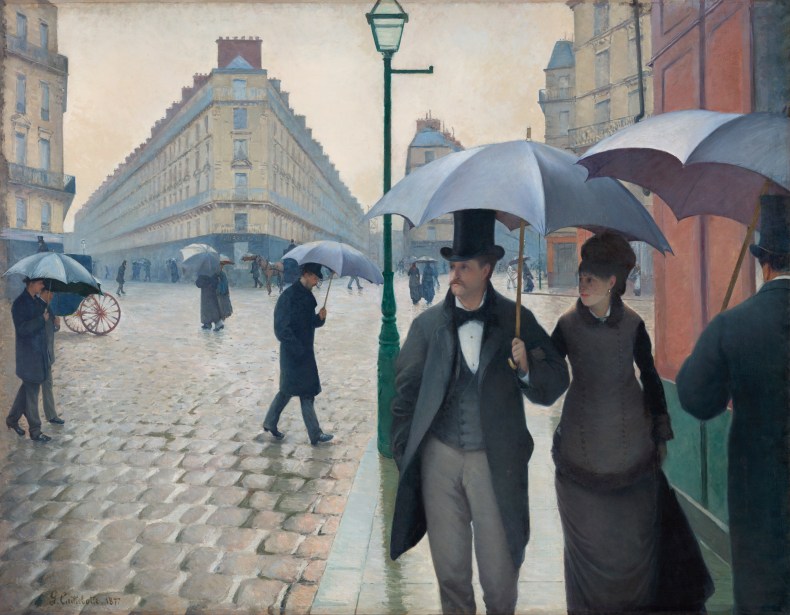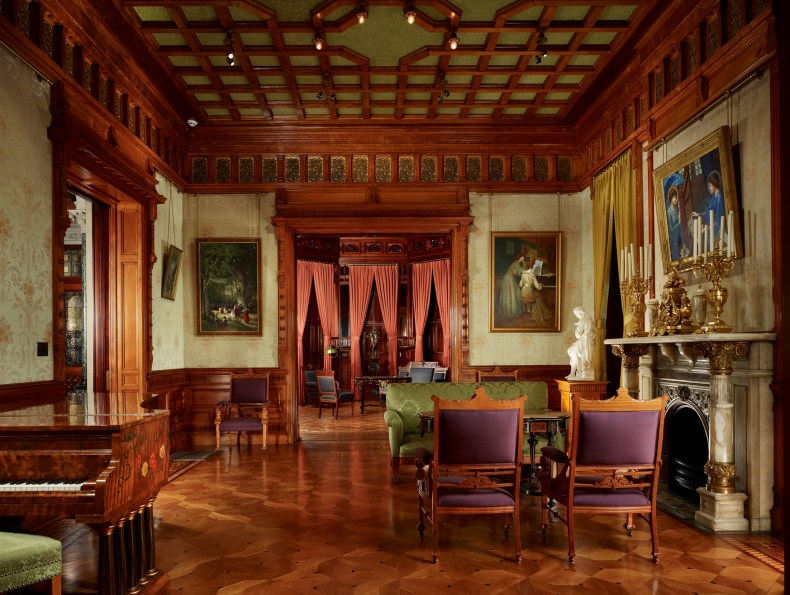Earlier this year I set out on a road-trip through America’s ‘Rust Belt’. This is the derogatory 1980s term for the north-eastern states whose economies declined rapidly after the collapse of their once-powerful industrial sector, which had driven the country’s economy from the late 19th to the mid 20th century. At its height, that power gave birth to some of American’s grandest city-landscaping and finest museum collections.
My route was from thriving Chicago to the reviving cities of Toledo, Cleveland and Detroit. Among the country’s 35,000 or so museums, Chicago’s Art Institute ranks at no. 5, Cleveland’s is no. 6, and Detroit’s no. 8. It was these that I headed out to see.
Paris Street: Rainy Day, (1877), Gustave Caillebotte. Art Institute of Chicago.

First stop, Chicago. There’s not much rust in evidence in the gleaming city centre. Chicago ranks today as America’s second city after New York; and the seventh city in the world. Historically, it rose thanks to its strategic position on Lake Michigan between the Great Lakes and the Mississippi River watershed, as well as its railway and canal, both of which opened in 1848. After the Great Chicago Fire of 1871 the city rose again, eschewing wood for steel and stone. This is where the skyscraper – thence the Chicago School of architecture – was born in 1885. William Le Baron Jenney’s Home Insurance Building was a dizzying 10-storey, 42-metre-high, fire-proof steel-skeleton that weighed a third of what a similar stone building would have. It so terrified locals that construction was halted while city officials investigated its safety. Today, even for a New York resident like me, strolling along the banks of the multi-bridged Chicago River, with its mix of restored industrial buildings and clusters of ever-taller towers, is neck-aching. The stiff entry fee to enjoy sunset from the nearby 348-metre high Hancock Tower (1970) is worth every cent: you are on top of the city (but only just, there are now three even taller towers) and feel you can see almost to each coast.
Back on the ground, the easiest way to check off the city’s best buildings in the Magnificent Mile and Loop districts is by downloading one of Chicago’s numerous architectural walks apps. Some places you can only enjoy from outside, such as the Wrigley Building; others you can go into. The Chicago Architecture Foundation has a model of the city in its soaring lobby, and runs all kinds of walks and tours including a bus trip to Oak Park to tour Frank Lloyd Wright’s home and studio – the original prairie house – followed by a walk to see a dozen or so FLW-designed houses nearby. In the garden of one stands an old ticket booth. It is a salvaged gem from Chicago’s legendary 1893 World’s Columbian Exposition, whose ‘white city’ of 200 neoclassical temporary buildings by J.W. Root and Daniel Burnham, with gardens by Frederick Law Olmsted, would help give birth to America’s City Beautiful Movement and be blamed for a century of white-stone, columned public buildings – especially museums.
The Art Institute of Chicago is the Magnificent Mile’s grandest public building. Its original Beaux-Arts edifice has received a series of additions, notably the Modern Wing by Renzo Piano (2009; currently showing the Edlis/Neeson Collection gift). The wing links to Millennium Park in one direction and, in the other, to the old building through a monumental gallery spanning disused railway lines and displaying highlights of its fine Asian collection. This encyclopaedic museum is one of America’s best. Currently, their newly rediscovered Sebastiano del Piombo is on show, and temporary exhibitions include ‘America after the Fall: Painting in the 1930s’ (until 18 September).
The drawing room at the Driehaus Museum. Photo: Steve Hall/Hedrich Blessing

Three lesser-known treats add to Chicago’s story. The Driehaus Museum (completed 1883) is a rare surviving Gilded Age mansion, built by banker Samuel Mayo Nickerson. Its exquisite Aesthetic Movement interior was restored by Richard H. Driehaus and houses Driehaus’s decorative arts collection. The Museum of Contemporary Art Chicago has one of the most uplifting shows in the US this summer: a retrospective of Kerry James Marshall’s bold, witty, colourful chronicles of African-American life (until 25 September). As the artist says in a recorded interview displayed in the show: ‘There are no black Old Masters. If you want to get into the game you’ve got to play it how the people at the highest level are playing it.’ He does just that. The third treat comes courtesy of the restored Chicago Athletic Association’s Venetian Gothic tower (1893). Now an impressive hotel, the bar’s balcony views stretch out across Lake Michigan’s sea-like waters. It’s hard to beat the simple pleasure of ending a day in Chicago on the roof of an architectural gem, glass in hand.
Next stop: Toledo


